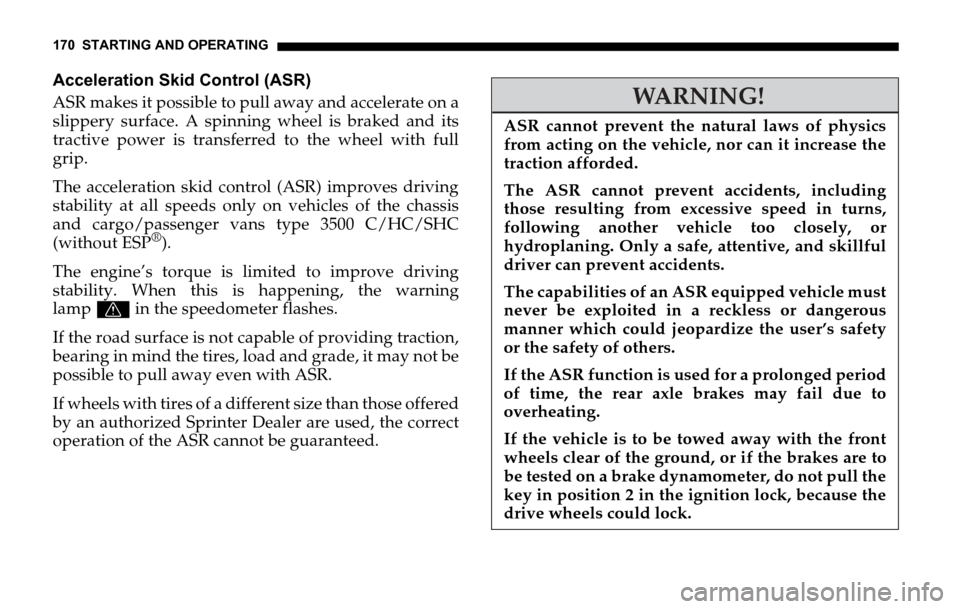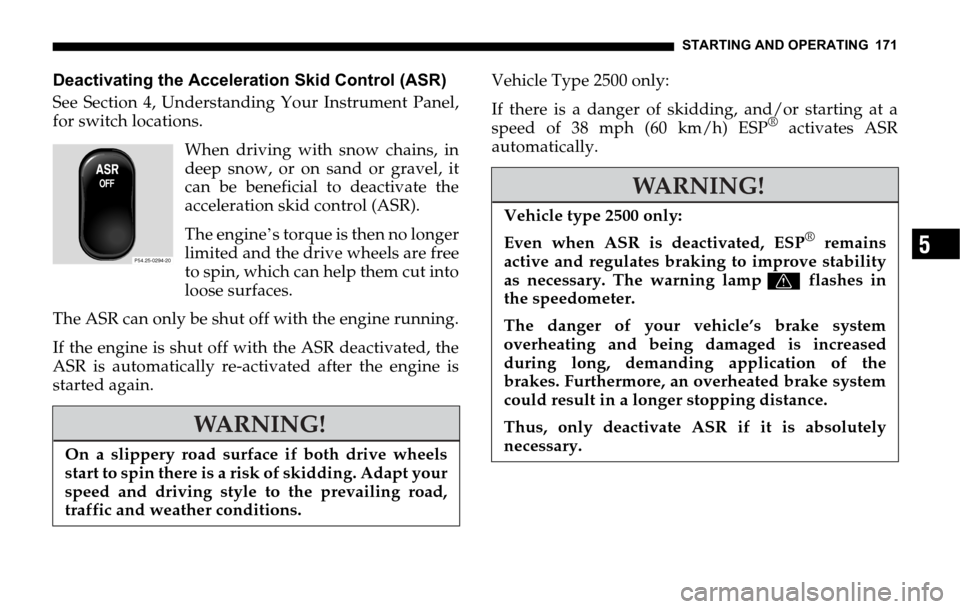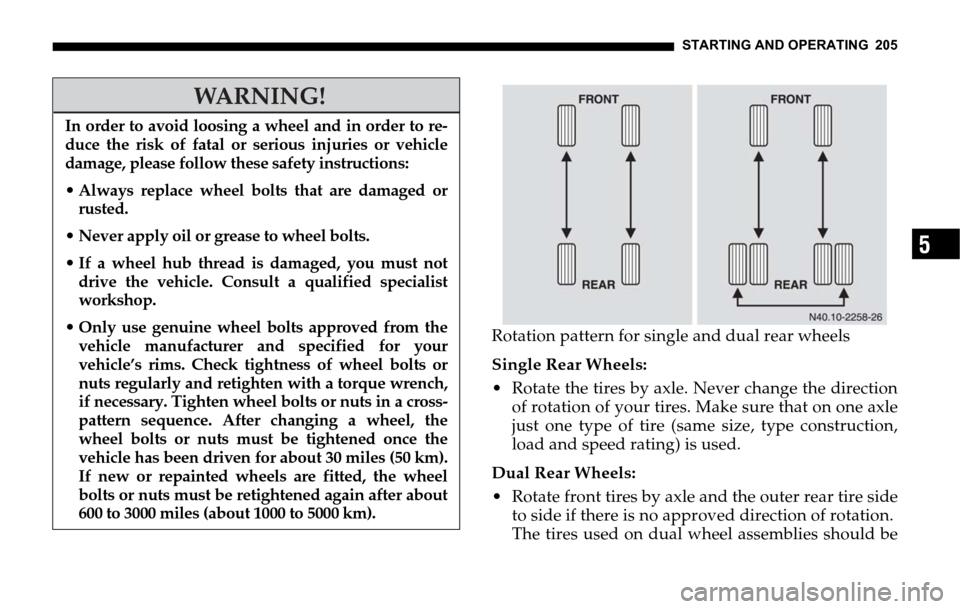wheel torque DODGE SPRINTER 2006 1.G Owners Manual
[x] Cancel search | Manufacturer: DODGE, Model Year: 2006, Model line: SPRINTER, Model: DODGE SPRINTER 2006 1.GPages: 330, PDF Size: 10.82 MB
Page 170 of 330

170 STARTING AND OPERATING
Acceleration Skid Control (ASR)
ASR makes it possible to pull away and accelerate on a
slippery surface. A spinning wheel is braked and its
tractive power is transferred to the wheel with full
grip.
The acceleration skid control (ASR) improves driving
stability at all speeds only on vehicles of the chassis
and cargo/passenger vans type 3500 C/HC/SHC
(without ESP
®).
The engine’s torque is limited to improve driving
stability. When this is happening, the warning
lampv in the speedometer flashes.
If the road surface is not capable of providing traction,
bearing in mind the tires, load and grade, it may not be
possible to pull away even with ASR.
If wheels with tires of a different size than those offered
by an authorized Sprinter Dealer are used, the correct
operation of the ASR cannot be guaranteed.
WARNING!
ASR cannot prevent the natural laws of physics
from acting on the vehicle, nor can it increase the
traction afforded.
The ASR cannot prevent accidents, including
those resulting from excessive speed in turns,
following another vehicle too closely, or
hydroplaning. Only a safe, attentive, and skillful
driver can prevent accidents.
The capabilities of an ASR equipped vehicle must
never be exploited in a reckless or dangerous
manner which could jeopardize the user’s safety
or the safety of others.
If the ASR function is used for a prolonged period
of time, the rear axle brakes may fail due to
overheating.
If the vehicle is to be towed away with the front
wheels clear of the ground, or if the brakes are to
be tested on a brake dynamometer, do not pull the
key in position 2 in the ignition lock, because the
drive wheels could lock.
Page 171 of 330

STARTING AND OPERATING 171
5
Deactivating the Acceleration Skid Control (ASR)
See Section 4, Understanding Your Instrument Panel,
for switch locations.
When driving with snow chains, in
deep snow, or on sand or gravel, it
can be beneficial to deactivate the
acceleration skid control (ASR).
The engine’s torque is then no longer
limited and the drive wheels are free
to spin, which can help them cut into
loose surfaces.
The ASR can only be shut off with the engine running.
If the engine is shut off with the ASR deactivated, the
ASR is automatically re-activated after the engine is
started again.Vehicle Type 2500 only:
If there is a danger of skidding, and/or starting at a
speed of 38 mph (60 km/h) ESP
® activates ASR
automatically.
WARNING!
On a slippery road surface if both drive wheels
start to spin there is a risk of skidding. Adapt your
speed and driving style to the prevailing road,
traffic and weather conditions.
P54.25-0294-20
WARNING!
Vehicle type 2500 only:
Even when ASR is deactivated, ESP
® remains
active and regulates braking to improve stability
as necessary. The warning lampv flashes in
the speedometer.
The danger of your vehicle’s brake system
overheating and being damaged is increased
during long, demanding application of the
brakes. Furthermore, an overheated brake system
could result in a longer stopping distance.
Thus, only deactivate ASR if it is absolutely
necessary.
Page 205 of 330

STARTING AND OPERATING 205
5
Rotation pattern for single and dual rear wheels
Single Rear Wheels:
Rotate the tires by axle. Never change the direction
of rotation of your tires. Make sure that on one axle
just one type of tire (same size, type construction,
load and speed rating) is used.
Dual Rear Wheels:
Rotate front tires by axle and the outer rear tire side
to side if there is no approved direction of rotation.
The tires used on dual wheel assemblies should be
WARNING!
In order to avoid loosing a wheel and in order to re-
duce the risk of fatal or serious injuries or vehicle
damage, please follow these safety instructions:
Always replace wheel bolts that are damaged or
rusted.
Never apply oil or grease to wheel bolts.
If a wheel hub thread is damaged, you must not
drive the vehicle. Consult a qualified specialist
workshop.
Only use genuine wheel bolts approved from the
vehicle manufacturer and specified for your
vehicle’s rims. Check tightness of wheel bolts or
nuts regularly and retighten with a torque wrench,
if necessary. Tighten wheel bolts or nuts in a cross-
pattern sequence. After changing a wheel, the
wheel bolts or nuts must be tightened once the
vehicle has been driven for about 30 miles (50 km).
If new or repainted wheels are fitted, the wheel
bolts or nuts must be retightened again after about
600 to 3000 miles (about 1000 to 5000 km).
Page 235 of 330

WHAT TO DO IN EMERGENCIES 235
6
Procedure:
1. Park the vehicle on a firm, level, non-slippery
surface.
2. Switch on the hazard warning flasher switch, apply
the parking brake, and place the transmission
selector in "P".3. Everyone must leave the vehicle before you jack it
up.
4. Everyone must leave the danger zone, before
jacking the vehicle.
5. The vehicle must be safeguarded in accordance
with legal regulations (such as using a warning
triangle).
6. Prevent vehicle from rolling away by blocking
wheels with wheel chocks (not supplied with
vehicle) or sizable wood block or stone.
On a level road, place one chock in front of and one
behind the wheel that is diagonally opposite to the
wheel being changed.
When changing a wheel on mild uphill or downhill
grades, place chocks on the downhill side blocking
both wheels of the other axle.
WARNING!
Do not jack the vehicle up more than 1.2 in (30
mm) between the tire and the surface. Otherwise,
the vehicle may tip over and may cause serious in-
jury or death to you or others.
Always lower the vehicle onto sufficient capacity
jack stands before working under the vehicle.
Precautions when changing a wheel:
For tire inflation pressures, see “Tire Pressures”
For the torque, refer to "Installing a wheel";
Do not damage, grease or oil wheel bolts or their
threads.
WARNING!
Do not change wheels on either steep uphill or
downhill grades. The vehicle may begin to move
and fall from the jack which could cause personal
injury and property damage.
Page 245 of 330

WHAT TO DO IN EMERGENCIES 245
6
Tighten the wheel bolts/nuts in a crosswise pattern
to the specified torque with a torque wrench.
Remove jack and stow it in the vehicle tool kit.
Check the tire inflation pressure.
Re-tighten the wheel bolts/nuts to the specified
torque with a torque wrench after a distance of 30
miles (about 50 km).
Vehicle
Type2500 C/H/SHC 3500 C/HC/SHC
Tire225/70 R 15 C LT 225/775 R 16 195/70 R 15 C LT 225/75 R 16
Rimsteel
6J x 15 ET75light-alloy
7J x 15 ET76steel
6J x 15 ET75light-alloy
6.5J x 16 ET70steel
5.5J x 15 HMA115steel
6J x 16 HMA129.5
Wheel
fittingwheel bolts wheel nuts
Tightening
torque133 lbf.ft ±7 lbf.ft
(180 N.m ±10 N.m)177 lbf.ft ±7 lbf.ft
(240 N.m ±10 N.m)133 lbf.ft ±7 lbf.ft
(180 N.m ±10 N.m)
Page 246 of 330

246 WHAT TO DO IN EMERGENCIES
JUMP STARTING
If the battery is dead, the engine can be started with
jumper cables from another vehicle’s battery.
WARNING!
After changing a wheel, you must, for safety reasons,
have the specified tightening torque checked. The
wheels could otherwise work loose.
check the tire inflation pressure and correct it if
necessary.
retighten the wheel bolts and wheel nuts to the
specified tightening torque once the vehicle has
been driven for 30 miles (50 km). If new or
repainted wheels are fitted, the wheel bolts or nuts
must be retightened again after about 600 to 3,000
miles (about 1,000 to 5,000 km).
have a reversed direction of tire rotation corrected
as soon as possible at a qualified specialist
workshop. The vehicle handling characteristics
could otherwise be affected.WARNING!
A battery will produce hydrogen gas, which is
flammable and very explosive. Avoid open flames
and the formation of sparks in the vicinity of the
batteries. Refrain from smoking or cell phone use.
Avoid improper connection of jumper cables.
Observe safety precautions when handling
batteries.
Exercise care near moving engine components and
electrical cables.
Failure to follow these directions will cause
damage to the electronic components and can lead
to a battery explosion and severe injury or death.